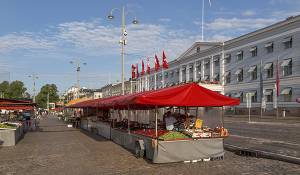In recent years, participatory budgeting has become more common in Finland and around the world as part of the planning of general government finances. An increasingly low voter turnout in elections may increase interest in the use of participatory budgeting in decision-making.
The idea of participatory budgeting may sound simple: giving people an opportunity to influence their environment directly, whereby they will probably select the best ideas. However, research shows that it is not quite as simple as this: the people who are the most eager to participate in decision-making are those who are already socially active.
Participatory budgeting (Opens in a new tab) is a process that provides citizens with an opportunity to influence the allocation of appropriations. The model can be used on all levels of government, but most of the experiments have been conducted on town or regional level.
Participatory budgeting projects in Finland have so far been relatively small
In Finland, participatory budgeting generated public debate for the first time in 2011 as a result of Sitra’s (Opens in a new tab) New Democracy project, which aimed at providing ideas on how to increase citizens’ participation in decision-making. In 2012, the City of Helsinki and Sitra implemented library improvements proposed by city residents with an appropriation of EUR 100,000. The City of Helsinki has also otherwise been a forerunner in participatory budgeting. In 2013, the model was extended to the Youth Department through RuutiBudjetti.
RuutiBudjetti (Opens in a new tab) allocates the Helsinki Youth Department an appropriation the uses of which are planned by young people together with the employees of the department. The share of RuutiBudjetti of the City’s total budget is small. However, it is noteworthy that the appropriation is allocated annually. The most important participatory budgeting experiment in Helsinki is the OmaStadi (Opens in a new tab) project. It allows the residents to decide how to use about EUR 4 million of the budget. The amount is distributed to the different districts of the City, and all residents over 12 years may vote and submit ideas on how to use the funds. The most recent OmaStadi project was implemented in 2018–2019, and an assessment on its implementation will be published later this year.

Participatory budgeting has become increasingly popular. However, according to a questionnaire survey conducted by the Association of Finnish Municipalities (Opens in a new tab) in 2018, only 12% of the municipalities (i.e. 22 municipalities) had tried it. The participatory budgeting experiments have been geographically concentrated in the Greater Helsinki Area. A project corresponding to Helsinki’s RuutiBudjetti is, for example, Espoo’s ManiMiitti, which enables Espoo’s young residents to participate in allocating the appropriation. A significant project in Tampere, in turn, was the revamp of the recreational area of Tesoma in 2014. The appropriation allocated to this project was EUR 110,000. In Tampere, the project that corresponds to Helsinki’s OmaStadi is Mun Tampere (Opens in a new tab), which has been allocated an appropriation of EUR 450,000. Vantaa (Opens in a new tab), in turn, allows the residents of Martinlaakso and Hakunila to decide on the use of EUR 50,000 of the budget funds. The aim is to make these areas more attractive. This is the third experiment in Vantaa. The first one was the Meidän Korso project in 2019.
So far, the participatory budgeting experiments in Finland have been small in relation to the number or total budgets of municipalities. For example, the largest participatory budgeting project in Finland, OmaStadi, is considerably smaller than corresponding experiments in other European towns, which may use several per cent of their budgets for participatory budgeting.
Another challenge is posed by the lack of continuity, as only about a half of the participatory budgeting projects are continuous, i.e. annually recurring. Moreover, if the social and health care reform is implemented, the continuation of participatory budgeting in municipalities is uncertain, as some of the municipalities’ tasks would become the responsibility of counties. The risk is that decision-making moves even further away from the residents, which might also reduce the transparency of public administration.
Participatory budgeting was first developed to meet the need for direct democracy in South America
The first participatory budgeting experiment was conducted in Porto Alegre (Opens in a new tab) in Brazil on the initiative of the Brazilian Labour Party (PT) in 1989. The experiment was substantially linked with the idea of radical democracy. Radical democracy (Opens in a new tab) refers to citizens’ direct participation in decision-making with the aim to improve the transparency of public administration. Non-governmental organizations have had an important role in the development of radical democracy. Another important idea underlying radical democracy is targeting resources at the poor. The Porto Alegre experiment was considered successful, and participatory budgeting was extended to other towns in Brazil and South America.

In addition to radical democracy, a liberal view of better governance has been highlighted when participatory budgeting has become a global phenomenon. According to the liberal view, participatory budgeting underlines good governance. Participatory budgeting has been actively promoted by international organizations, particularly the World Bank (Opens in a new tab) and UN-Habitat. The World Bank has supported several developing countries in projects aiming at better governance. Participatory budgeting is, in fact, closely linked with Sustainable Development Goal 16 on good governance in the 2030 Agenda.
The most significant promoter of participatory budgeting after the World Bank and the UN is the European Union (Opens in a new tab). The EU provides development aid to Latin America, for example, through a programme where the focus is on promoting participatory budgeting.
After South America, participatory budgeting is utilized the most in Europe, although the model does not extend to the EU budgeting. The method is mainly applied on regional or municipal level. Poland has even incorporated participatory budgeting into the national law, and Portugal has financed projects from the state budget.
The results of an international survey (Opens in a new tab)(Open budget survey) conducted in 2019 show that several countries have difficulties in achieving sufficient transparency in their budgeting. According to the report, the countries with a transparent budgeting process are more democratic, developed and equal than average. The key idea in participatory budgeting is indeed to involve citizens in decision-making and to improve the transparency of public administration.
Most of the participatory budgeting surveys and projects have been targeted at local and regional government. The possibility of using participatory budgeting in different states’ budgeting processes would require more research.
Participatory budgeting has been implemented by four different methods
The ways of implementing participatory budgeting can be divided into four different methods (Opens in a new tab). The first one is named according to the best-known town where participatory budgeting was experimented, i.e. Porto Alegre. In this model, participatory budgeting is included in the budget of a town or municipality, and citizens submit budget proposals in cooperation with public officials. The Porto Alegre experiment, which started at the end of the 1980s, is the clearest example of this type of budgeting, where one of the underlying ideas was radical democracy.
Another method is to allocate an appropriation, as for example in the library project in Helsinki. The problem with this method is that the projects are often one-off initiatives, which means that they do not necessarily lead to the targeted long-term development of municipal democracy.
In the third, percentage-based model, citizens are allowed to decide on the use of a certain share of the municipal budget. In this model, citizens are fully entitled to decide on allocations, while the local government is only responsible for implementing the decisions. In 2017, Pudasjärvi introduced a percentage for participatory budgeting with the aim, in particular, to increase employment and achieve other socio-economic improvements.
The fourth and last method is the ‘pooling’ model, where funding from several different sources is directed at the development of a certain area. An example of the pooling model is the building of a foot and cycle path in the municipality of Karvia in 2010. The funding for the project came from several actors, and the residents were actively involved in both the planning and implementation.
All of these four methods are represented in the participatory budgeting experiments conducted in Finland. The most frequently used ones are the Porto Alegre model and the appropriation model.
Could participatory budgeting be extended to the state budget?
Perhaps the biggest risk related to participatory budgeting is, paradoxically, the participatory deficit. Even if the aim is to involve as many citizens as possible, it is possible that only the most active ones actually participate. A project that has aimed at being inclusive risks becoming exclusive. For example, organizing voting regarding the spending of funds mainly online places people who do not use the Internet in a somewhat unequal position even if it were possible to submit proposals and vote in other ways as well.
Could participatory budgeting be extended to state budget? A challenge to this idea may be posed by the fact that the state budget process is far more complicated than the municipal one. Another challenge may be posed by the question of the position of representative democracy.
The participatory deficit detected in municipal experiments would most probably also apply to the state budget. However, it would be justified to look into the opportunities of participatory budgeting even on central government level, as especially the experiences gained in Brazil in the 1980s show that, at its best, participatory budgeting can increase well-being. Participatory budgeting might also bring new perspectives on the budget structure or how it is presented.
The international umbrella organization of Supreme Audit Institutions, INTOSAI, cooperates with the International Budget Partnership, which supports the development of open budgeting in over a hundred countries. It has, for example, published a Government Guide (Opens in a new tab) on transparent budgeting. According to the organization, budget information should be understandable to citizens, as they have the right to obtain information on the collection and use of public funds and to influence this process.
Writer: Miro Kapanen. Kapanen was a trainee at the International Relations team of the National Audit Office in May–August 2020.

